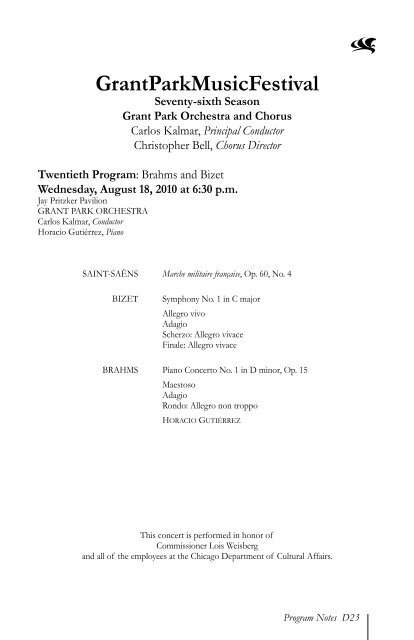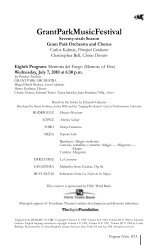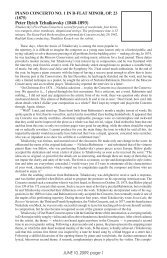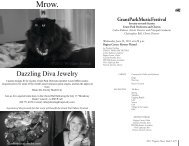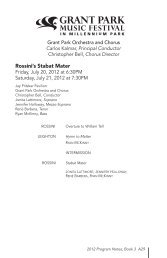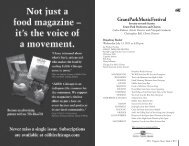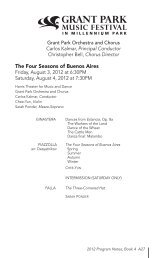cute Brahms Bizet.pdf - The Grant Park Music Festival
cute Brahms Bizet.pdf - The Grant Park Music Festival
cute Brahms Bizet.pdf - The Grant Park Music Festival
Create successful ePaper yourself
Turn your PDF publications into a flip-book with our unique Google optimized e-Paper software.
<strong>Grant</strong><strong>Park</strong><strong>Music</strong><strong>Festival</strong><br />
Seventy-sixth Season<br />
<strong>Grant</strong> <strong>Park</strong> Orchestra and Chorus<br />
Carlos Kalmar, Principal Conductor<br />
Christopher Bell, Chorus Director<br />
Twentieth Program: <strong>Brahms</strong> and <strong>Bizet</strong><br />
Wednesday, August 18, 2010 at 6:30 p.m.<br />
Jay Pritzker Pavilion<br />
GRANT PARK ORCHESTRA<br />
Carlos Kalmar, Conductor<br />
Horacio Gutiérrez, Piano<br />
SAINT-SAËNS Marche militaire française, Op. 60, No. 4<br />
BIZET<br />
Symphony No. 1 in C major<br />
Allegro vivo<br />
Adagio<br />
Scherzo: Allegro vivace<br />
Finale: Allegro vivace<br />
BRAHMS Piano Concerto No. 1 in D minor, Op. 15<br />
Maestoso<br />
Adagio<br />
Rondo: Allegro non troppo<br />
HORACIO GUTIÉRREZ<br />
This concert is performed in honor of<br />
Commissioner Lois Weisberg<br />
and all of the employees at the Chicago Department of Cultural Affairs.<br />
Program Notes D23
GRANT PARK MUSIC FESTIVAL Wednesday, August 18, 2010<br />
D26 Program Notes<br />
MARCHE MILITAIRE FRANÇAISE, OP. 60, NO. 4 (1880)<br />
Camille Saint-Saëns (1835-1921)<br />
<strong>The</strong> Marche militaire française is scored for piccolo, two flutes, two oboes, two<br />
clarinets, two bassoons, four horns, two trumpets, two cornets, three trombones, tuba,<br />
timpani, percussion and strings. <strong>The</strong> performance time is approximately six minutes.<br />
<strong>The</strong> <strong>Grant</strong> <strong>Park</strong> Orchestra first performed the Marche militaire française on August<br />
8, 1935, Ebba Sundstrom conducting.<br />
In July 1879, Saint-Saëns wrote a Rêverie Orientale for a concert arranged by the pianist Wilhelmina<br />
Szavardy to benefit the victims of a flood in the Szégédin district of her native Hungary.<br />
<strong>The</strong> Rêverie was a musical memento of the composer’s moonlight visit to the exotic Algerian town<br />
of Blidah five years before, and in July 1880, while on a seaside holiday at Boulogne-sur-mer, he<br />
surrounded it with three other orchestral postcards to create the Suite Algérienne; Edouard Colonne<br />
conducted the work’s premiere at the Théâtre du Châtelet on July 19, 1880. <strong>The</strong> Suite closes with a<br />
flamboyant Marche militaire française that speaks not only of Saint-Saëns’ patriotic pride but also of<br />
the colonial domination that France had held in Algeria for the preceding three decades.<br />
SYMPHONY NO. 1 IN C MAJOR (1855)<br />
Georges <strong>Bizet</strong> (1838-1875)<br />
<strong>Bizet</strong>’s Symphony in C major is scored for woodwinds in pairs, four horns, two trumpets,<br />
timpani and strings. <strong>The</strong> performance time is approximately 27 minutes. <strong>The</strong><br />
<strong>Grant</strong> <strong>Park</strong> Orchestra first performed this Symphony on July 13, 1945, Nikolai<br />
Malko conducting.<br />
Georges <strong>Bizet</strong> lived for only three dozen years, and each of those dozens<br />
marked an important phase of his short life. During the first twelve years, only little time was<br />
devoted to the usual activities of childhood, since Georges, the offspring of two talented musicians,<br />
was breathtakingly precocious in musical matters. He was admitted to the Paris Conservatoire at<br />
the age of nine and was winning prizes there within a year. He produced his earliest known works,<br />
two vocalises for soprano, at twelve.<br />
<strong>The</strong> second dozen years of <strong>Bizet</strong>’s life were the happiest he was to know. He studied at the<br />
Conservatoire until he was nineteen, garnering awards for piano, organ, fugue and solfeggio, and<br />
composing a variety of works, one of which was a prize-winning operetta in a competition sponsored<br />
by Jacques Offenbach. At nineteen, he won the Prix de Rome, which supplied him with a fiveyear<br />
stipend, a residency in Italy and France, and the opportunity to devote himself to composition.<br />
He did complete several works during this time, but he projected far more that came to nothing.<br />
Despite developing a throat ailment that plagued him all his life, <strong>Bizet</strong> was active enough during<br />
those years to establish a modest reputation as a composer and an excellent one as a pianist. <strong>The</strong><br />
years of planning, composing and travel came to an end when his prize stipend expired. At the age<br />
of 24 he was faced with the perplexing reality of providing his own living.<br />
After 1863, <strong>Bizet</strong> gave much of his time to all manner of musical hackwork: private teacher,<br />
rehearsal accompanist, music critic, but mostly to transcribing the popular pieces of the day for<br />
a variety of instruments. “It is maddening to interrupt the work I love for two days in order to<br />
write cornet solos. Still, one must live!” he lamented. He continued to plan many works for both<br />
opera house and concert hall, but had to abandon most of these because of lack of time. From<br />
these later years date the works for which he is mainly remembered: <strong>The</strong> Pearl Fishers, Jeux d’enfants,<br />
the incidental music to L’Arlésienne and Carmen. None of these pieces provided him the success he<br />
worked so hard to achieve, however, and he lived in a state of continual frustration that Winton<br />
Dean described as “settled melancholy.” “We often sensed tears in his voice,” a friend wrote. <strong>Bizet</strong><br />
died before he knew that Carmen would make his name famous around the world.<br />
<strong>Bizet</strong>’s Symphony in C, written in his seventeenth year, is a marvel of early musical maturation<br />
that rivals the precocity of Mozart and Mendelssohn. It is a work in which the composer exhibited<br />
his careful study of, among others, Haydn, Rossini and Gounod (Gounod was <strong>Bizet</strong>’s counterpoint
Wednesday, August 18, 2010<br />
GRANT PARK MUSIC FESTIVAL<br />
teacher whose own First Symphony had appeared only a year earlier), and vitalized it with his own<br />
ebullient, youthful spirit and characteristic touches of melody, harmony and orchestration. Curiously,<br />
the work seems not to have been performed during <strong>Bizet</strong>’s lifetime. <strong>The</strong> manuscript became<br />
part of his estate after his death and passed into the possession of his wife, who did not fully<br />
appreciate her husband’s genius. She bequeathed it to the composer Reynaldo Hahn, and he to<br />
the Paris Conservatoire Library, where it gathered dust until <strong>Bizet</strong>’s first English biographer, D.C.<br />
<strong>Park</strong>er, unearthed it in 1933. It was finally premiered on February 26, 1935 in Basle, Switzerland<br />
by Felix Weingartner.<br />
<strong>The</strong> Symphony in C opens with a movement in traditional sonata form, with a bubbling main<br />
theme outlining chordal patterns and a contrasting legato second theme, introduced by the oboe,<br />
in longer notes. <strong>The</strong> slow second movement contains a haunting, bittersweet serenade for oboe<br />
followed by a soaring melody for strings. <strong>The</strong> movement is rounded out by the return of the oboe<br />
theme. <strong>The</strong> concluding two movements are a sprightly scherzo with a rustic-sounding trio, and a<br />
vivacious finale, cast, like the first movement, in sonata form.<br />
PIANO CONCERTO NO. 1 IN D MINOR, OP. 15 (1854-1859)<br />
Johannes <strong>Brahms</strong> (1833-1897)<br />
<strong>Brahms</strong>’ Piano Concerto No. 1 is scored for woodwinds and trumpets in pairs, four<br />
horns, timpani and strings. <strong>The</strong> performance time is approximately 44 minutes. <strong>The</strong><br />
<strong>Grant</strong> <strong>Park</strong> Orchestra first performed this Concerto on July 29, 1959. <strong>The</strong>odore<br />
Bloomfield conducted, and Gary Graffman was the soloist.<br />
<strong>Brahms</strong>, in his philosophy and his attitude toward music, was the first<br />
modern composer. He emerged as a creator around 1850, at just the time when the signs of interest<br />
in the centuries-long history of music first became evident. During earlier generations, a composer<br />
developed his style based almost exclusively on knowledge of only his own and the immediately<br />
preceding generations, choosing either to continue composing around the same aesthetic principles<br />
or to change them in subtle or drastic ways. At no time before the 19th century was the music of<br />
earlier eras emulated, venerated or, in most cases, even known. <strong>The</strong> exceptions are few: notably, the<br />
oratorios of Handel, the contrapuntal church style of Palestrina and the Well-Tempered Clavier of<br />
Bach, and even the last two of these were more familiar from pedagogy than from performance.<br />
<strong>Brahms</strong>, unlike those before him, drew from the entire history of German music — from Lassus<br />
to Bach to Beethoven — and, in so doing, was the first composer to face that set of imposing questions<br />
for the creative artist about the historical flow of musical tradition: “What do I keep?” “What<br />
do I discard?” “Where do I fit in?”<br />
<strong>The</strong> 19th century was a time of many noteworthy explorations into the past. Schliemann unearthed<br />
Troy; Champollion broke the code of the Rosetta Stone; and a determined French scholar<br />
named Coussemaker brushed away seven centuries of dust and forgetfulness to expose the earliest<br />
music of western civilization. <strong>Brahms</strong> saw himself not only as the beneficiary of this newly discovered<br />
treasure from earlier times, but also as its curator, a responsibility he accepted as a scholar<br />
as well as a composer: he was on the advisory board of the first complete edition of the works of<br />
Bach. In his compositions, <strong>Brahms</strong> forged a distinctive style from three of the great traditions of<br />
German music — the lush and luxuriant textures of Lassus and Bach, the formal techniques of<br />
Beethoven and the emotionally expressive harmony of Schumann. <strong>Brahms</strong> brought to this amalgam<br />
his own wonderful lyricism and sense of musical architecture.<br />
<strong>Brahms</strong> did battle with the problem of creating something new without defacing the tradition<br />
he revered in every work he wrote. Nowhere is the struggle more evident, however, than in the First<br />
Symphony and this First Piano Concerto. He labored for five years on the Concerto before it was<br />
performed, and then went back and revised it some more. His original intention was to produce a<br />
symphony in D minor as his first major orchestral work, and, to that end, he sketched three movements<br />
in short score in 1854. <strong>The</strong> first movement was orchestrated, but <strong>Brahms</strong> was not satisfied<br />
with the result, and he decided to transform his short score into a sonata for two pianos. But even<br />
this did not fulfill his vision, as he noted in a letter to Joseph Joachim, violinist, conductor and<br />
Program Notes D27
Wednesday, August 18, 2010<br />
GRANT PARK MUSIC FESTIVAL<br />
encouraging friend: “I have often played the first three movements over with Frau Schumann [the<br />
composer’s widow, and the center of <strong>Brahms</strong>’ musical and emotional existence for most of his life],<br />
but I find that I require even more than two pianos.” <strong>The</strong> ideas were too symphonic in breadth to<br />
be satisfactorily contained by just pianos, yet too pianistic in figuration to be completely divorced<br />
from the keyboard. <strong>Brahms</strong> was quite stuck.<br />
In 1857, the composer Julius Otto Grimm, a staunch friend of <strong>Brahms</strong>, suggested that his<br />
24-year-old colleague try his sketch as a piano concerto. <strong>Brahms</strong> thought the advice sound, and<br />
he went back to work. He selected two movements to retain for the concerto and put aside the<br />
third, which emerged ten years later as the chorus Behold All Flesh in the German Requiem. Things<br />
proceeded slowly, with <strong>Brahms</strong> soliciting the advice of Grimm, Joachim and Clara Schumann, and<br />
only after two more years did he feel the work ready for performance. <strong>Brahms</strong> himself gave the<br />
premiere on January 22, 1859 with the Orchestra of the Royal <strong>The</strong>ater, Hanover; Joseph Joachim<br />
conducted.<br />
<strong>The</strong> Concerto’s stormy first movement is the most openly passionate and impetuous of all<br />
<strong>Brahms</strong>’ orchestral works. Joachim wrote to Max Kalbeck, the composer’s eventual biographer, that<br />
this music reflected the anguish <strong>Brahms</strong> felt over the nervous breakdown and attempted suicide<br />
of Robert Schumann just as <strong>Brahms</strong> was working on his D minor sketch. <strong>The</strong> movement may also<br />
show the impact of Beethoven’s Ninth Symphony, which overwhelmed <strong>Brahms</strong> when he first heard<br />
it in March of 1854. This movement follows the Classical model of double-exposition concerto<br />
form, with an extended initial presentation of much of the important thematic material by the<br />
orchestra alone (“first exposition”). <strong>The</strong> soloist enters and leads through the “second exposition,”<br />
which is augmented to include a lyrical second theme, not heard earlier, played by the unaccompanied<br />
piano. <strong>The</strong> central section of the movement begins with the tempestuous main theme, a truly<br />
Romantic motive filled with snarling trills and anguished melodic leaps. <strong>The</strong> recapitulation enters<br />
on a titanic wave of sound, as though the crest of some dark, brooding emotion were crashing<br />
onto a barren, rocky shore. <strong>The</strong> lovely second theme returns (played again by the solo piano), but<br />
eventually gives way to the foreboding mood of the main theme. Looking back over the craggy<br />
grandeur of this movement, it is not difficult to imagine what must have caused the audience at the<br />
Leipzig premiere to reject the Concerto. <strong>The</strong>re is no flashy virtuoso work here, not even a cadenza,<br />
but only an equal partnership between soloist and orchestra in music that is serious in content and<br />
broad in scope.<br />
<strong>The</strong> Adagio is a movement of transcendent beauty, of quiet, twilight emotions couched in<br />
a mood of gentle melancholy — of “something spiritual” in Clara Schumann’s words. Above<br />
the first line of Joachim’s score, <strong>Brahms</strong> penciled in the phrase “Benedictus qui venit in nomine<br />
Domini” — “Blessed is he who comes in the name of the Lord.” This reference, really an informal<br />
dedication, is to Robert Schumann, who died while <strong>Brahms</strong> was working on the Concerto.<br />
Schumann was often addressed by his friends as “Mynheer Domine.” An additional dedication may<br />
be to Schumann’s widow, the Clara so dear to <strong>Brahms</strong> during those years, because he wrote to her<br />
that he was “also painting a lovely portrait of you. It is to be the Adagio.” Such an overt association<br />
of his music with definite sentiments was highly unusual for <strong>Brahms</strong>, and he later crossed out the<br />
Latin phrase in the conductor’s score. <strong>The</strong> emotion of deep tranquility untouched by life’s vicissitudes,<br />
however, remains.<br />
<strong>The</strong> finale, perhaps modeled on that of Beethoven’s C minor Piano Concerto, is a weighty<br />
rondo. Its theme is related to the lyrical second subject of the opening movement by one of those<br />
masterful strokes <strong>Brahms</strong> used to unify his large works. Among the episodes that separate the<br />
returns of the rondo theme is one employing a carefully devised fugue that grew directly from<br />
<strong>Brahms</strong>’ intensive study of the music of Bach. After a brief, restrained cadenza, the coda turns to<br />
the brighter key of D major to provide a stirring conclusion to this Concerto, a work of awesome<br />
achievement for the 26-year-old <strong>Brahms</strong>.<br />
©2010 Dr. Richard E. Rodda<br />
Program Notes D29


